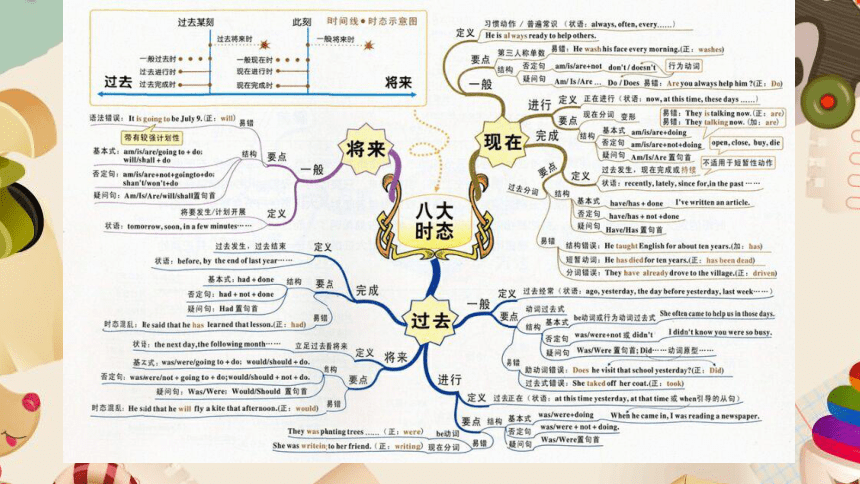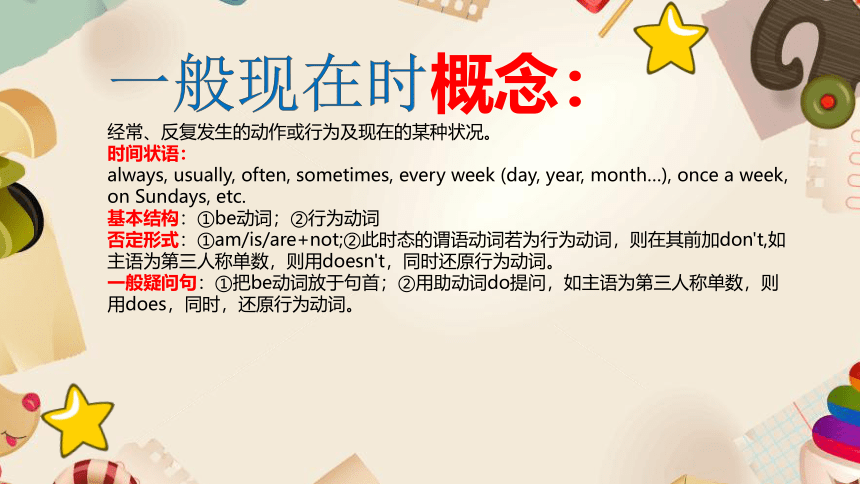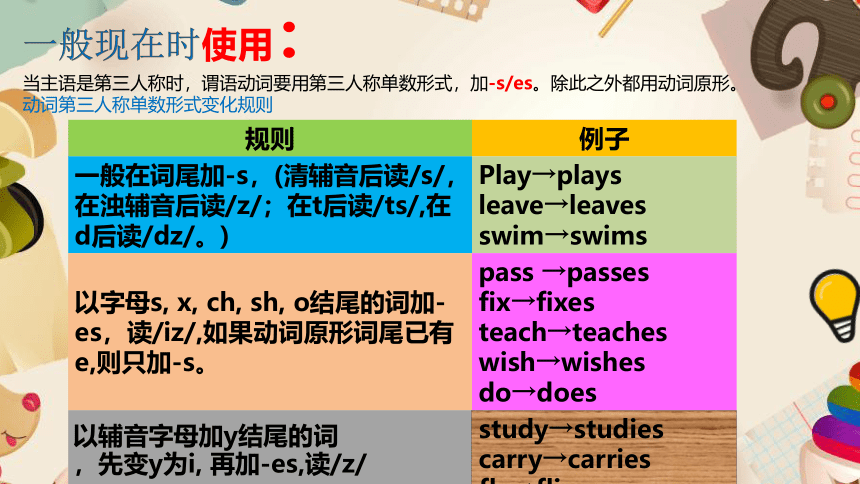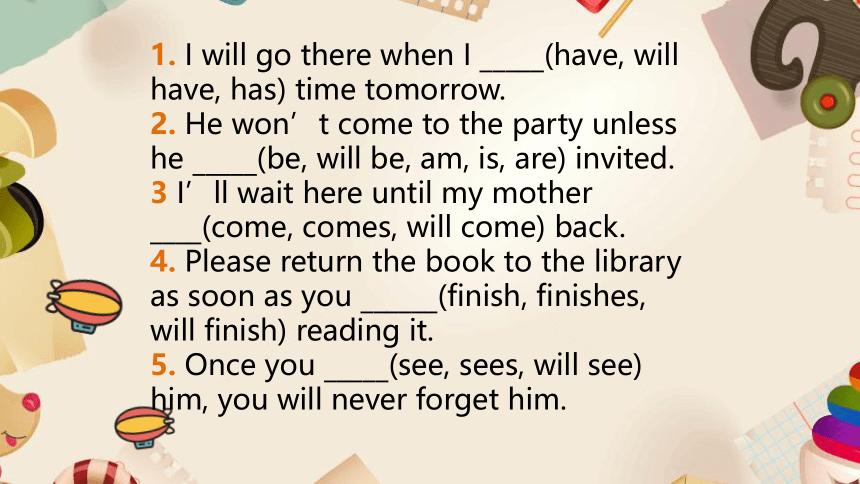时态辨析课件(共21张PPT)
图片预览









文档简介
(共21张PPT)
初中时态辨析
一般现在时
一般现在时概念:
经常、反复发生的动作或行为及现在的某种状况。
时间状语:
always, usually, often, sometimes, every week (day, year, month…), once a week, on Sundays, etc.
基本结构:①be动词;②行为动词
否定形式:①am/is/are+not;②此时态的谓语动词若为行为动词,则在其前加don't,如主语为第三人称单数,则用doesn't,同时还原行为动词。
一般疑问句:①把be动词放于句首;②用助动词do提问,如主语为第三人称单数,则用does,同时,还原行为动词。
一般现在时使用:
①表示经常或习惯性的动作或存在的状态。
②表示主语通常的能力、兴趣爱好、和性格特征。
③表示客观的事实或真理。
④表示按照时刻表或已经计划安排好的将来行为。(只限于是go, come, leave, arrive, begin, start, take off, stop, be等表示开始或移动意义的词。)⑤在时间状语从句和条件状语从句中,主句用一般将来时(will+动词原形),从句中用一般现在时表将来。(主将从现)
一般现在时使用:
当主语是第三人称时,谓语动词要用第三人称单数形式,加-s/es。除此之外都用动词原形。
动词第三人称单数形式变化规则
规则 例子
一般在词尾加-s,(清辅音后读/s/,在浊辅音后读/z/;在t后读/ts/,在d后读/dz/。) Play→plays leave→leaves
swim→swims
以字母s, x, ch, sh, o结尾的词加-es,读/iz/,如果动词原形词尾已有e,则只加-s。 pass →passes fix→fixes
teach→teaches wish→wishes
do→does
以辅音字母加y结尾的词 ,先变y为i, 再加-es,读/z/ study→studies carry→carries
fly→flies
1. He______(be, am, is, are) a teacher at No. 2 Middle School.
2. He______(have, has) classes in the afternoon.
3. He______(get, gets) up at half past six every morning.
4. He ______(study, studies) very hard at his lesson.
5. One and two _____(be, is, are) three.
6. Blue and yellow _____(make, makes) green.
7. I will go there if I ____( be, will be, am, is, are) free tomorrow.
1. I will go there when I _____(have, will have, has) time tomorrow.
2. He won’t come to the party unless he _____(be, will be, am, is, are) invited.
3 I’ll wait here until my mother ____(come, comes, will come) back.
4. Please return the book to the library as soon as you ______(finish, finishes, will finish) reading it.
5. Once you _____(see, sees, will see) him, you will never forget him.
现在完成时
CHAPTER THREE
现在完成时概念:
表示发生在过去,持续到现在,可能刚刚结束也有可能继续进行下去的动作或状态,甚至延续到将来,并对现在造成一定的影响或结果。常与since+过去时(间), for+一段时间连用。表示与现在有联系的过去的动作。
现在完成时用法:
之非延续性动词和延续性动词
非延续性动词在时间上没有延续性,常见的有come, go, arrive, leave, begin, start, buy, join, die, buy, find, stop, become, open, borrow, lend, appear, close, fall, finish, sell, lose, kill等,这些动词不能和表示一段时间的时间状语连用。 但是,非延续性动词的否定形式可以表示状态的延续,可与for/since等时间状语连用。
现在完成时用法:
1.时间状语:yet, already, just, never, ever, so far, by now, since+时间点,for+时间段,recently, lately, in the past few years, etc.
2.基本结构:主语+have/has +p.p(过去分词)+其他
3.否定形式:主语+have/has + not +p.p(过去分词)+其他
4.一般疑问句:have/has+主语 +p.p(过去分词)+其他
现在完成时用法:
之非延续性动词和延续性动词
有些同学错误地认为这类非延续性动词不能用于完成时态中。其实,错误的本质在于非延续性动词与时间段的错误搭配,与现在完成时态无关。
延续性语境中的非延续性动词的使用
在具体的语言环境中,往往会出现非延续性动词与时间段相连用的情况。由于受汉语影响,往往错误地直译为:
He has fallen asleep for an hour.
他睡了一小时了。(×)
His father has died for three years.
他父亲去世三年了。(×)
当出现这种情况时,我们往往采取以下解决方法:
现在完成时用法:
之非延续性动词和延续性动词
将非延续性动词转化为相应的状态动词。所谓状态动词就是指这一动作发生后接下来所呈现的状态。如:
He has been asleep for an hour. (fall asleep,“入睡”为短暂动作,但be asleep“睡着”则为状态动词,可延续。)
His father has been dead for three years.(die为短暂动词,“死”后的状态可用“be dead”这种系表结构来描述,可延续。)
现在完成时用法:
之非延续性动词和延续性动词
常见的这种动词的转化有以下几类:
go there—be there, come back—be back, borrow—keep, buy/catch—have, arrive—be in, begin—be on, open—be open, close—be closed, die—be dead, leave—be away from, get up—be up, fall asleep—be asleep, become—be, join—be in/a member of, receive—have, catch/get a cold—have a cold, get married—be married,come → be in,finish → be over, leaver → be away
现在完成时用法:
have (has)been 和have (has) gone 的区别
have been to a place意思是“到过、去过”,表示曾到过某处,但现在人不在那儿;
have gone to a place表示“去了”,已经去了某地,现在人可能在去的途中或已经到那儿了。
现在完成时用法:
1.You have _____ a tall young man.
A grown B grown into C grown us D grown up
2. He has ____ the watch for a year.
A buy B bought C have D had
3. Has your brother _____ the dog
A kept in B fed C fed on D kept on
4. I _____this book for two weeks, I have to return it now.
A borrowed B have borrowed C kept D have kept
5. Have you ever _____to the Great Wall It's very beautiful.
A gone B been C went D go
6. Her brother _____the Party since 1978.
A joined B has joined C has been in D was in
7. The Greens _____many places of interest since they came to China.
A will visit B visited C have visited D visit
现在完成时用法:
8.I'm sorry, I ____ your name.
A had forgotten B forgot
C have forgotten D forgotten
9 The bookshop _____ for eight years.
A has been open B has been opened
C has opened D has open
10 We have_____ all the paper so we need to buy some.
A used up B made of
C filled with D hunted for
11 The flower I ____grown up.
A planted has B planted have
C has planted D have planted
我的总结
感谢观看
DESIGNED BY ALONIC
初中时态辨析
一般现在时
一般现在时概念:
经常、反复发生的动作或行为及现在的某种状况。
时间状语:
always, usually, often, sometimes, every week (day, year, month…), once a week, on Sundays, etc.
基本结构:①be动词;②行为动词
否定形式:①am/is/are+not;②此时态的谓语动词若为行为动词,则在其前加don't,如主语为第三人称单数,则用doesn't,同时还原行为动词。
一般疑问句:①把be动词放于句首;②用助动词do提问,如主语为第三人称单数,则用does,同时,还原行为动词。
一般现在时使用:
①表示经常或习惯性的动作或存在的状态。
②表示主语通常的能力、兴趣爱好、和性格特征。
③表示客观的事实或真理。
④表示按照时刻表或已经计划安排好的将来行为。(只限于是go, come, leave, arrive, begin, start, take off, stop, be等表示开始或移动意义的词。)⑤在时间状语从句和条件状语从句中,主句用一般将来时(will+动词原形),从句中用一般现在时表将来。(主将从现)
一般现在时使用:
当主语是第三人称时,谓语动词要用第三人称单数形式,加-s/es。除此之外都用动词原形。
动词第三人称单数形式变化规则
规则 例子
一般在词尾加-s,(清辅音后读/s/,在浊辅音后读/z/;在t后读/ts/,在d后读/dz/。) Play→plays leave→leaves
swim→swims
以字母s, x, ch, sh, o结尾的词加-es,读/iz/,如果动词原形词尾已有e,则只加-s。 pass →passes fix→fixes
teach→teaches wish→wishes
do→does
以辅音字母加y结尾的词 ,先变y为i, 再加-es,读/z/ study→studies carry→carries
fly→flies
1. He______(be, am, is, are) a teacher at No. 2 Middle School.
2. He______(have, has) classes in the afternoon.
3. He______(get, gets) up at half past six every morning.
4. He ______(study, studies) very hard at his lesson.
5. One and two _____(be, is, are) three.
6. Blue and yellow _____(make, makes) green.
7. I will go there if I ____( be, will be, am, is, are) free tomorrow.
1. I will go there when I _____(have, will have, has) time tomorrow.
2. He won’t come to the party unless he _____(be, will be, am, is, are) invited.
3 I’ll wait here until my mother ____(come, comes, will come) back.
4. Please return the book to the library as soon as you ______(finish, finishes, will finish) reading it.
5. Once you _____(see, sees, will see) him, you will never forget him.
现在完成时
CHAPTER THREE
现在完成时概念:
表示发生在过去,持续到现在,可能刚刚结束也有可能继续进行下去的动作或状态,甚至延续到将来,并对现在造成一定的影响或结果。常与since+过去时(间), for+一段时间连用。表示与现在有联系的过去的动作。
现在完成时用法:
之非延续性动词和延续性动词
非延续性动词在时间上没有延续性,常见的有come, go, arrive, leave, begin, start, buy, join, die, buy, find, stop, become, open, borrow, lend, appear, close, fall, finish, sell, lose, kill等,这些动词不能和表示一段时间的时间状语连用。 但是,非延续性动词的否定形式可以表示状态的延续,可与for/since等时间状语连用。
现在完成时用法:
1.时间状语:yet, already, just, never, ever, so far, by now, since+时间点,for+时间段,recently, lately, in the past few years, etc.
2.基本结构:主语+have/has +p.p(过去分词)+其他
3.否定形式:主语+have/has + not +p.p(过去分词)+其他
4.一般疑问句:have/has+主语 +p.p(过去分词)+其他
现在完成时用法:
之非延续性动词和延续性动词
有些同学错误地认为这类非延续性动词不能用于完成时态中。其实,错误的本质在于非延续性动词与时间段的错误搭配,与现在完成时态无关。
延续性语境中的非延续性动词的使用
在具体的语言环境中,往往会出现非延续性动词与时间段相连用的情况。由于受汉语影响,往往错误地直译为:
He has fallen asleep for an hour.
他睡了一小时了。(×)
His father has died for three years.
他父亲去世三年了。(×)
当出现这种情况时,我们往往采取以下解决方法:
现在完成时用法:
之非延续性动词和延续性动词
将非延续性动词转化为相应的状态动词。所谓状态动词就是指这一动作发生后接下来所呈现的状态。如:
He has been asleep for an hour. (fall asleep,“入睡”为短暂动作,但be asleep“睡着”则为状态动词,可延续。)
His father has been dead for three years.(die为短暂动词,“死”后的状态可用“be dead”这种系表结构来描述,可延续。)
现在完成时用法:
之非延续性动词和延续性动词
常见的这种动词的转化有以下几类:
go there—be there, come back—be back, borrow—keep, buy/catch—have, arrive—be in, begin—be on, open—be open, close—be closed, die—be dead, leave—be away from, get up—be up, fall asleep—be asleep, become—be, join—be in/a member of, receive—have, catch/get a cold—have a cold, get married—be married,come → be in,finish → be over, leaver → be away
现在完成时用法:
have (has)been 和have (has) gone 的区别
have been to a place意思是“到过、去过”,表示曾到过某处,但现在人不在那儿;
have gone to a place表示“去了”,已经去了某地,现在人可能在去的途中或已经到那儿了。
现在完成时用法:
1.You have _____ a tall young man.
A grown B grown into C grown us D grown up
2. He has ____ the watch for a year.
A buy B bought C have D had
3. Has your brother _____ the dog
A kept in B fed C fed on D kept on
4. I _____this book for two weeks, I have to return it now.
A borrowed B have borrowed C kept D have kept
5. Have you ever _____to the Great Wall It's very beautiful.
A gone B been C went D go
6. Her brother _____the Party since 1978.
A joined B has joined C has been in D was in
7. The Greens _____many places of interest since they came to China.
A will visit B visited C have visited D visit
现在完成时用法:
8.I'm sorry, I ____ your name.
A had forgotten B forgot
C have forgotten D forgotten
9 The bookshop _____ for eight years.
A has been open B has been opened
C has opened D has open
10 We have_____ all the paper so we need to buy some.
A used up B made of
C filled with D hunted for
11 The flower I ____grown up.
A planted has B planted have
C has planted D have planted
我的总结
感谢观看
DESIGNED BY ALONIC
同课章节目录
- 词法
- 名词
- 动词和动词短语
- 动词语态
- 动词时态
- 助动词和情态动词
- 非谓语动词
- 冠词
- 代词
- 数词和量词
- 形容词副词及其比较等级
- 介词和介词短语
- 连词和感叹词
- 构词法
- 相似、相近词比较
- 句法
- 陈述句
- 一般疑问句和否定疑问句
- 特殊疑问句及选择疑问句
- 反意疑问句
- 存在句(There be句型)
- 宾语从句
- 定语从句
- 状语从句
- 主谓一致问题
- 简单句
- 并列句
- 复合句
- 主谓一致
- 主、表语从句
- 名词性从句
- 直接引语和间接引语
- 虚拟语气
- 感叹句
- 强调句
- 倒装句
- 祈使句
- 句子的成分
- 句子的分类
- 题型专区
- 单项选择部分
- 易错题
- 完形填空
- 阅读理解
- 词汇练习
- 听说训练
- 句型转换
- 补全对话
- 短文改错
- 翻译
- 书面表达
- 任务型阅读
- 语法填空
- 其他资料
